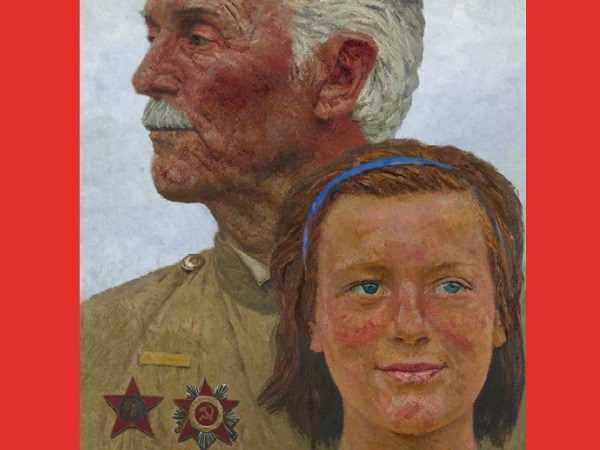Gely Korzhev (1925-2012), one of the leading figures in Soviet and Russian painting of the second half of the 20th century, is back to Venice. His return to the lagoon takes place exactly57 years after his participation in the XXXI Biennale. Together with Viktor Popkov, he became a spokesman of “Severe style” at the Pavilion of the USSR that year, presenting the works that sought to find new expressive devices within the framework of Socialist realism, not yet questioned by the artists. The means that would go beyond a strict canon of the Stalinist era.
The exhibition “Gely Korzhev. Back to Venice” is organised by the State Tretyakov Gallery, theInstitute of Russian Realist Art and the Centre of Studies of Russian Art (CSAR) at Ca' FoscariUniversity of Venice in collaboration with Intesa Sanpaolo. It brings to light the relevance of Korzhev’s triptych, his contribution to the exhibition at the Pavilion of 1962, other significant details concerning that exhibition through archival documents, photographs, screenings, and the use of Information and Communication Technologies. Following a large retrospective exhibition of Korzhev’s work at the State Tretyakov Gallery, the project features more than 50 paintings by the master. It is the opportunity to present to the public a complete vision of his oeuvre that will allow for re-evaluation of the judgments once made on the occasion of the XXXI Biennale.
THE EXHIBITION
This show does not seek to become an anthology in the strict sense. It extends in a series of well-articulated thematic blocks and critically revisits selected aspects of the artist’s work. A parade of monumental nudes, extraordinary still-lives, and some of other successful examples of his unique interpretation of Soviet realist painting will be displayed.
The core of the exhibition is, however, turbulent imagery associated with the memory of World War II that has been known as the Great Patriotic War in Soviet and Russian culture. These works secured greater international recognition to Korzhev. For instance, Burnt by War (1963-1964) was deliberately selected as a poster image of the important 2003 exhibition "Berlin-Moscow Moscow-Berlin" at Martin Gropius Bau among more than 500 works. The final part of the project is devoted to Korzhev’s reflections on the Soviet system collapse and is represented by the paintings that balance between empathy and decisive social critique, sometimes resulting being as grotesque as in hybrid Tyurliki creatures and the skeletons of the USSR. The exhibition, as its title suggests, is also the occasion to reread, after more than half a century, that Venetian debut of Korzhev.
In 1962 Larisa Salmina, the commissioner of Russian Pavilion, delineated the selection criteria for artists who would represent Russian artistic culture in this very delicate moment of its history, that of the Khrushchev Thaw, in following terms: “During the XXXI International Art Exhibition, Soviet art is represented by artist of different nationalities and generations. The work of these artists gives an idea of the richness of creative manners and subjects that may illustrate the life of the Soviet people. It shows that Soviet art is profoundly humanistic”. The discourse on rising diversity of creative languages and generation change alongside the need for a firm link to "the life of the Soviet people" that was still strong enough to explain why acknowledged academics and the young hopes were presented next to Korzhev and Popkov.
Korzhev exhibited a self-portrait in motion (The Artist of 1961 where the artist on his knees is working on a small female nude in chalk on the edge of the sidewalk, next to a beret with a few coins thrown by passers-by) and, most importantly, the large-scale triptych Communists (1957- 1960), now at the State Russian Museum in Saint Petersburg. The composition of the first canvas (by order of execution), entitled International, is dominated by two standing figures, two soldiers of the Red Army on a battlefield. One of them blows the horn while the other, depicted from behind, holds the flag of the regiment. The second work, which is the only one to have a horizontal irregular layout, entitled Raising the flag, draws a civilian kneeling to pick up the red flag dropped by a fallen comrade. The third one Homer (The Studio) features a sculptor in military garb working on a portrait bust of the Greek poet. The exhibition also included paintings by Deineka and The Builders of Bratsk by Popkov (the masterpiece that became a core of Popkov’s retrospective exhibition held at Ca’ Foscari 5 years ago). Speaking about the works of this kind, Renato Guttuso used the term “resistentialism” while Italian critics saw them as “exhausting efforts for renewal” (Mario De Micheli) or “ongoing retreat”, to quote “Il Gazzettino” contributor Paolo Rizzi who claimed the ambiguity of the question: “To destalinise painting in the socialist countries. Yes, of course, as if everything depended on Stalin, as if it was enough to erase his portraits from the walls. […] That would be way too easy to say that all the artistic creation in the Soviet Union and socialist countries are on the threshold of a conscious renewal that does not undermine the values but rather strengthens them”. Almost sixty years after, this opinion may be reconsidered.
GELY KORZHEV. BACK TO VENICE
CURATED BY FAINA BALACHOVSKAJA, GIUSEPPE BARBIERI, SILVIA BURINI, AND NADEZHDA STEPANOVA
Ca'Foscari Esposizioni, Dorsoduro 3246
10 May – 3 November 2019
Hours: Tuesday to Sunday (closed on Mondays)
From 10 to 18
Free admission
Scientific Secretariat: Center for Studies on the Arts of Russia (CSAR) Media partner: THE ART NEWSPAPER RUSSIA











